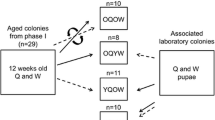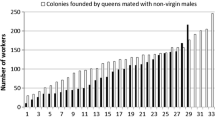Abstract
Queen and worker Bombus terrestris have different optima for the timing of gyne production. Workers, being more related to their gyne-sisters than to their sons, should ascertain that gyne production has started before attempting to reproduce. Their optimal timing for gyne production will be as early as possible, while allowing sufficient ergonomic colony growth to support gyne rearing. Queen optimum, on the other hand, should be to postpone gyne production toward the end of colony life cycle, in order to minimize the time-window available for worker reproduction. Thus, the timing of gyne production may profoundly affect the outcome of queen–worker competition over male production. In this study we investigated some of the social correlates possibly affecting this timing. It was found that neither keeping colony size constant and as low as 20 workers, nor decreasing worker average age, influenced the onset of gyne production. To test the effect of queen age we created young colonies with old queens and vice versa. When colony social composition remained unchanged, in young colonies headed by old queens gynes were produced earlier than predicted, but in the inverse situation gyne production was not delayed. When colony social composition was completely standardized queen age had a decisive effect, indicating that the timing of gyne production is both under queen influence and affected by queen age. Furthermore, queens assess colony age from the time of first worker emergence rather than from their own first oviposition. In these experiments the factors affecting gyne production also affected the onset of queen–worker conflict for male production, suggesting that both are regulated by the same causal effect. Postponing gyne production as much as possible provides another mechanism, in addition to extensive oophagy, for the queen to outcompete her workers in male production.


Similar content being viewed by others
References
Alaux C, Jaisson P, Hefetz A (2004a) Queen influence on worker reproduction in bumblebees (Bombus terrestris) colonies. Insectes Soc 51:287–293
Alaux C, Savarit F, Jaisson P, Hefetz A (2004b) Does the queen win it all? Queen–worker conflict over male production in the bumblebee, Bombus terrestris. Naturwissenschaften 91:400–403
Baer B, Schmid-Hempel P (2003) Effects of selective episodes in the field on life history traits in the bumblebee Bombus terrestris. Oikos 101(3):563–568
Beekman M, van Stratum P (1998) Bumblebee sex ratios: why do bumblebees produce so many males? Proc R Soc Lond B 265:1535–1543
Beekman M, van Stratum P (2000) Does the diapause experience of bumblebee queens Bombus terrestris affect colony characteristics? Ecol Entomol 25:1–6
Bloch G (1999) Regulation of queen–worker conflict in bumblebee (Bombus terrestris) colonies. Proc R Soc Lond B 266:2465–2469
Bloch G, Hefetz A (1999) Regulation of reproduction by dominant workers in bumblebee (Bombus terrestris) queenright colonies. Behav Ecol Sociobiol 45:125–135
Bortolotti L, Duchateau MJ, Sbrenna G (2001) Effect of juvenile hormone on caste determination and colony processes in the bumblebee Bombus terrestris. Entomol Exp Appl 101:143–158
Bourke AFG, Ratnieks F (1999) Kin conflict over caste determination in social Hymenoptera. Behav Ecol Sociobiol 46:287–297
Bourke AFG, Ratnieks F (2001) Kin-selected conflict in the bumble-bee Bombus terrestris (Hymenoptera: Apidae). Proc R Soc Lond B 268:347–355
Bowers MA (1985) Experimental analyses of competition between two species of bumblebees (Hymenoptera, Apidae). Oecologia 67:224–230
Bowers MA (1986) Resource availability and timing of reproduction in bumblebee colonies (Hymenoptera: Apidae). Environ Entomol 15:750–755
Cnaani J, Borst DW, Huang ZY, Robinson GE, Hefetz A (1997) Caste determination in Bombus terrestris: differences in development and rates of JH biosynthesis between queen and worker larvae. J Insect Physiol 43:373–381
Cnaani J, Robinson GE, Bloch G, Hefetz A (2000a) The effect of queen–worker conflict on caste determination in the bumblebee Bombus terrestris. Behav Ecol Sociobiol 47:346–352
Cnaani J, Robinson GE, Hefetz A (2000b) The critical period for caste determination in Bombus terrestris and its juvenile hormone correlates. J Comp Physiol A 186:1089–1094
Cohen D (1971) Maximizing final yield when growth is limited by time or by limiting resources. Behav Ecol Sociobiol 12:165–173
Crozier RH, Pamilo P (1996) Evolution of social insect colonies. Oxford University Press, Oxford, 306 p
Duchateau MJ, Velthuis HHW (1988) Development and reproductive strategies in Bombus terrestris colonies. Behavior 107:186–207
Duchateau MJ, Velthuis HHW, Boomsma JJ (2004) Sex ratio variation in the bumblebee Bombus terrestris. Behav Ecol 15:71–82
Keller L, Nonacs P (1993) The role of queen pheromones in social insects: queen control or queen signal? Anim Behav 45:787–794
Lopez-Vaamonde C, Koning JW, Jordan WC, Bourke AFG (2003) No evidence that reproductive bumblebee workers reduce the production of new queens. Anim Behav 66(3):577–584
Lopez-Vaamonde C, Koning JW, Jordan WC, Bourke AFG (2004a) A test of information use by reproductive bumblebee workers. Anim Behav 68:611–618
Lopez-Vaamonde C, Koning JW, Brown RM, Jordan WC, Bourke AFG (2004b) Social parasitism by male-producing reproductive workers in a eusocial insect. Nature 430:557–560
Müller CB, Schmid-Hempel P (1992) Variation in life-history pattern in relation to worker mortality in the bumble-bee, Bombus lucorum. Funct Ecol 6:48–56
Müller CB, Shykoff JA, Sutcliffe GH (1992) Life history patterns and opportunities for queen–worker conflict in bumblebees (Hymenoptera: Apidae). Oikos 65:242–248
Oster GF, Wilson EO (1978) Caste and ecology in the social insects. Princeton University Press, Princeton, NJ
Pereboom JJM, Velthuis HHW, Duchateau MJ (2003) The organization of larval feeding in bumblebees (Hymenoptera, Apidae) and its significance to caste differentiation. Insectes Soc 50:127–133
Reeve HK, Gamboa GJ (1983) Queen regulation of worker foraging in paper wasps: the role of the queen (Polistes fuscatus, Hymenoptera: Vespidae). Behav Ecol Sociobiol 13:63–74
Röseler PF (1970) Unterschiede in der Kastendetermination zwischen den Hummelnarten Bombus hypnorum und Bombus terrestris. Z Naturwiss 25:543–548
Röseler PF (1991) Roles of morphogenetic in caste polymorphism in bumble bees. In: Gupta AP (ed) Morphogenetic hormones of arthropods. Rutgers University Press, New Brunswick, NJ, pp 384–399
Schmid-Hempel P, Durrer S (1991) Parasites, floral resources, and reproduction in natural population of bumblebees. Oikos 62:342–350
Schmid-Hempel P, Heeb D (1991) Worker mortality and colony development in bumblebees, B lucorum L. Mitt Schweizerischen Entomol Ges 64:93–108
Schmid-Hempel R, Schmid-Hempel P (1998) Colony performance and immunocompetence of a social insect, Bombus terrestris, in poor and variable environments. Funct Ecol 12:22–30
Shykoff JA, Müller CB (1995) Reproductive decisions in bumble-bee colonies: the influence of worker mortality in Bombus terrestris (Hymenoptera, Apidae). Funct Ecol 9:109–112
Sutcliffe GH, Plowright RC (1988) The effects of food supply on adult size in the bumblebee Bombus terricola Kirby (Hymenoptera, Apidae). Can Entomol 120:1051–1058
van der Blom J (1986) Reproductive dominance within colonies of Bombus terrestris (L). Behavior 97:37–49
van Doorn A, Heringa J (1986) The ontogeny of a dominance hierarchy in colonies of the bumblebee Bombus terrestris (Hymenoptera, Apidae). Insectes Soc 33:3–25
Winston MLH, Higo HA, Slessor KN (1990) Effect of various dosages of queen mandibular gland pheromone on the inhibition of queen rearing in the honey bee (Hymenoptera: Apidae). Ann Entomol Soc Am 83:234–238
Acknowledgements
We are grateful to Paul Devienne for technical assistance and help in bee rearing. We also thank Rumsaïs Blatrix for helpful comments, Naomi Paz for editorial assistance and two anonymous reviewers for helpful comments. This work was funded by a J. and M.L. Dufrenoy grant to C.A. The experiments comply with the current laws of France.
Author information
Authors and Affiliations
Corresponding author
Additional information
Communicated by L. Keller
Rights and permissions
About this article
Cite this article
Alaux, C., Jaisson, P. & Hefetz, A. Reproductive decision-making in semelparous colonies of the bumblebee bombus terrestris . Behav Ecol Sociobiol 59, 270–277 (2005). https://doi.org/10.1007/s00265-005-0035-6
Received:
Revised:
Accepted:
Published:
Issue Date:
DOI: https://doi.org/10.1007/s00265-005-0035-6




